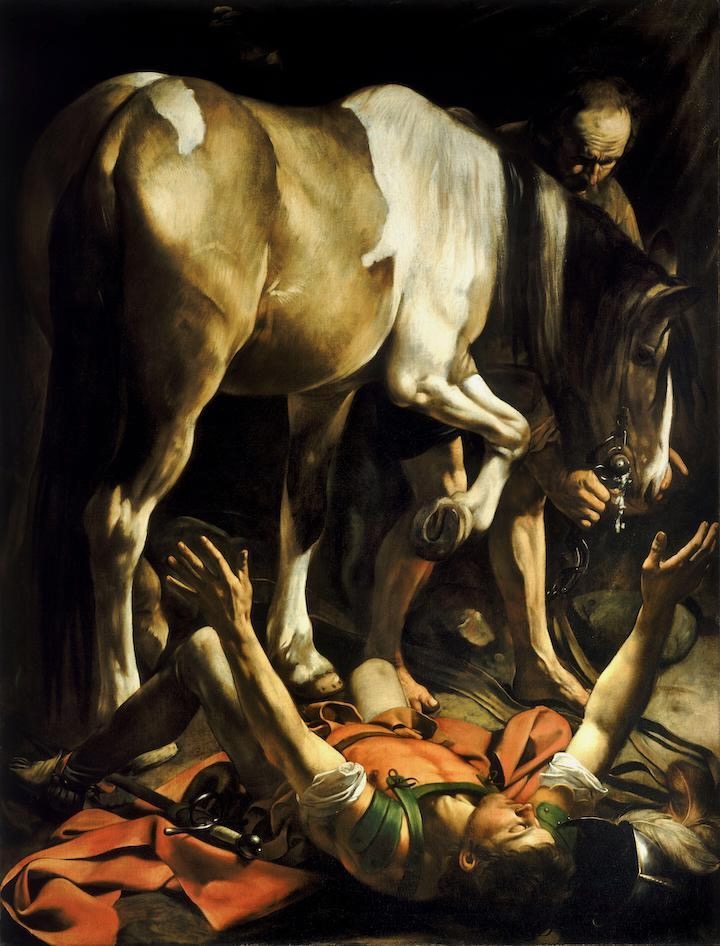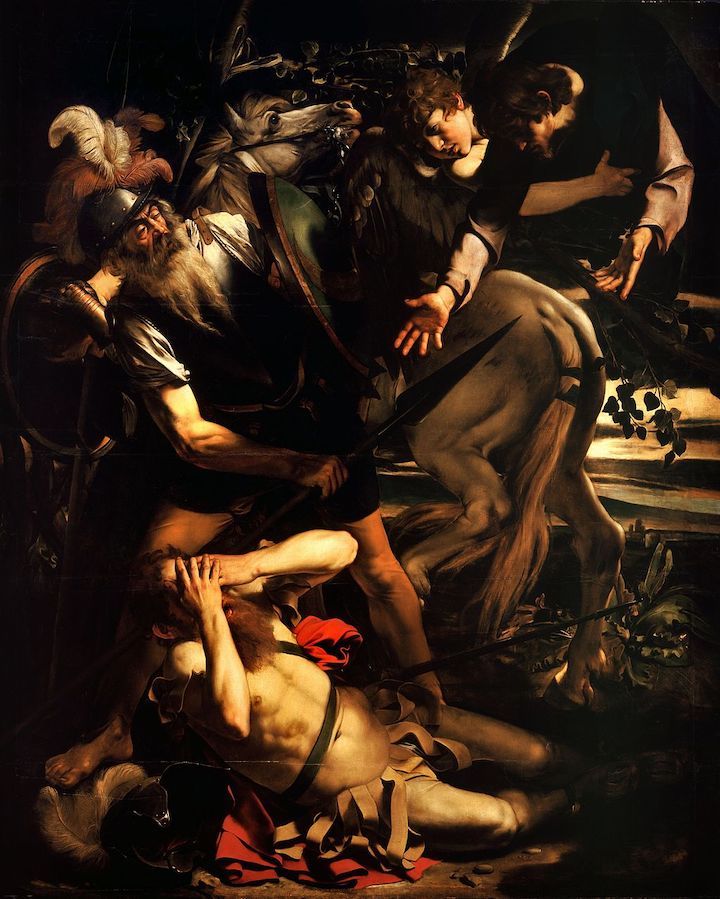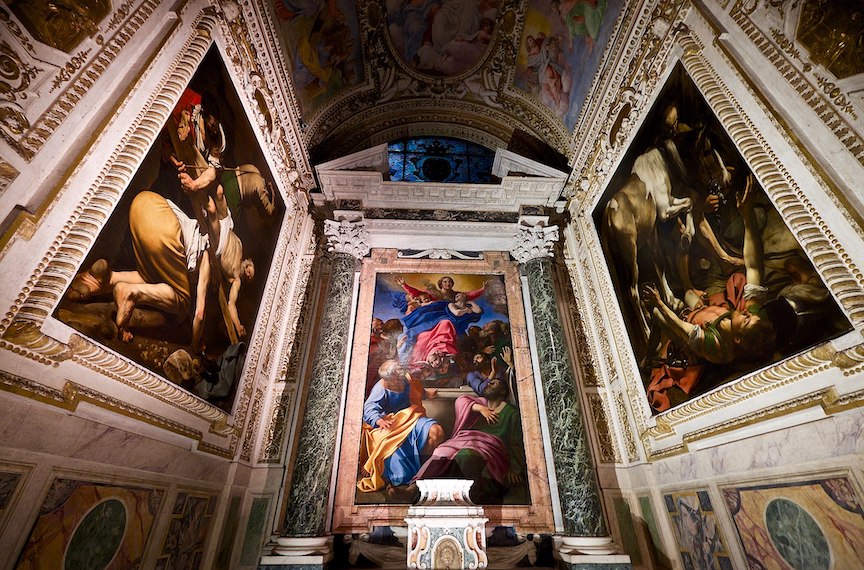It’s the Year of Our Lord 34, and Saul is on his way to Damascus to persecute “the Way,” as Luke puts it in Acts 9. Then – all of a sudden – BOOM!
“Saul, Saul, why do you persecute me?”
I imagine a force accompanying the flash of “light from heaven”: a kind of silent explosion, as of a vacuum suddenly created or vacated. In any case, it knocks Saul from his horse. The horse is a disputed detail, not found explicitly in the text and partly an artistic embellishment, although Christ does say to Saul, “get up and enter the city, and you will be told what you are to do.” Note: Get up.
To me, this is the most fascinating and epoch-making of all the Biblical stories of the apostolic era: no blinding light, no Apostle Paul. It’s a moment painted by many artists, including twice by Michelangelo Merisi da Caravaggio (1571-1610): once in 1600 in The Conversion of Saint Paul (now in a private Roman villa, the Palazzo Odescalchi Balbi); and a year later in Conversion of Saint Paul on the Road to Damascus (in situ at the Cerasi Chapel of the church of Santa Maria del Popolo, also in Rome).
It’s interesting to note that the Odescalchi Conversion was a reject and the Cerasi a second attempt to please the patron who’d refused the first. (This happened a number of times in Caravaggio’s career.)
His two versions of Saul’s fall differ significantly. In the more famous Cerasi Chapel version, the soon-to-be Apostle to the Gentiles is clean-shaven and supplicating, his eyes closed and his arms outstretched: not necessarily Why me? but possibly My Lord and my God! He is certainly in shock – or ecstasy, which in the context is probably the same.

His single companion is a man with furrowed brow who looks down at his fallen companion with concern, as he holds the reins of the horse. Indeed, the horse dominates the image. One hoof is raised, as though the horse has been stopped in mid-stride by that flash of light – or because he fears trampling his fallen rider. Is that other fellow a groom who was tending the animal as Saul mounted? Wait: Are they still in Jerusalem?
Art historian James Gardner has written that the painting stunned its early-17th-century viewers because of
the absence of any specific references to the saint; the painting could represent any accidental event that might take place in any stable. One might almost believe that a dream is being represented here, in which the dreamer, through the curious logic of such things, realizes that he is only dreaming and will not be hurt, and so surrenders entirely to his vision.
Caravaggio knew the Scripture passage (his patron would have seen to that), and Acts tells us that Saul “was going along and approaching Damascus,” and that the “men who were traveling with him stood speechless because they heard the voice [of Christ] but saw no one.”
And in the Odescalchi version (below), three men are pictured.
Not only is he blinded by the light of Christ’s call, but the red-bearded Saul is also stripped of most of his clothing – only his pteruges remains, artfully covering the area beneath his waist.
A pteruges (from the Greek, meaning feathers) was a defensive garment consisting of thick leather strips worn about the waist by Roman soldiers – offering protection to a . . . delicate area – and, if it displays a soldier’s rank, is known as a cingulum.

This invites the matter of the famous name change, Saul to Paul.
It did not come in this moment of conversion, although it is reminiscent of the transformations of Sarai into Sarah and Abram into Abraham and of Simon into Peter. Saul wasn’t only a Jew, as he attests before the tribune in Acts 22:25-28: “I was born a [Roman] citizen,” as his father had been before him. Thus, the Roman garb befitting the violent task of the man “still breathing threats and murder against the disciples of the Lord.” (Acts 9:1)
I said that in the Odescalchi Caravaggio, Paul is surrounded by three men, as in Acts. Well, some have asserted that the two on the viewer’s right are actually an angel and our Lord.
I’m skeptical.
Why would the “angel” restrain Jesus? Why would Jesus be dressed in what appears to be a Dominican habit? (And resembles the garment worn by the evangelist in the artist’s earlier The Martyrdom of Saint Matthew.)
Then again, above and behind that middle, cherubic face. . .is that a wing?

But why would the hands of Jesus, reaching out to Paul, not bear the marks of the nails that pierced His hands?
Then again, in both versions (1601 and 1602) of Caravaggio’s The Incredulity of St. Thomas this is also true. Christ’s hand – pulling back his garment so Thomas may see and touch the spear wound – bears no mark of the nail. This is true again in the London version of The Supper at Emmaus (1602).
In fact, the only Caravaggio work in which a wound is shown in Christ’s hand is Entombment (1603).
Those two figures in the Odescalchi – if Caravaggio meant them to be Jesus and an angel – do seem to be hovering in midair. But why no nimbus? Caravaggio did paint halos – and of elegant simplicity – but did so inconsistently.
Is this a pre- and post-Ascension matter? I invite the opinions of others, experts or not.
Caravaggio is sometimes spoken of as representative not only of the Baroque period in painting but also of the Catholic Counter-Reformation. He is certainly the former.
But the case is easily made that Caravaggio was hardly pious, so if his work had an evangelical effect on his contemporaries, we may have his patrons to thank for that. Peter Paul Rubens he was not.
__________















